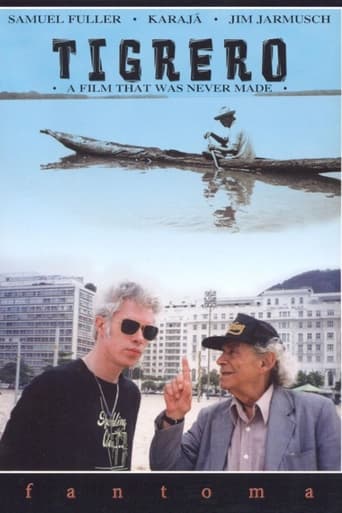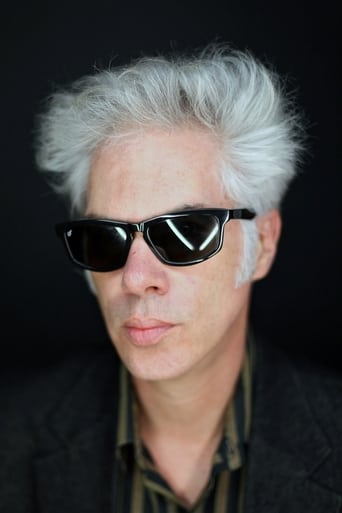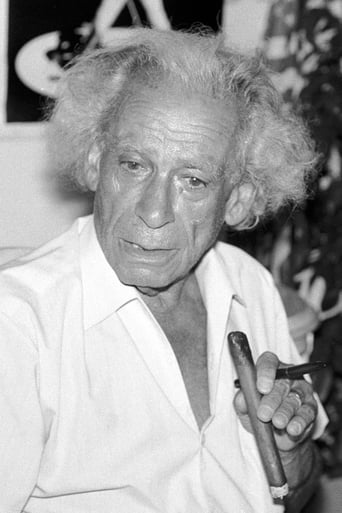

Tigrero: A Film That Was Never Made (1994)
In 1993, Sam Fuller takes Jim Jarmusch on a trip into Brazil's Mato Grosso, up the River Araguaia to the village of Santa Isabel Do Morro, where 40 years before, Zanuck had sent Fuller to scout a location and write a script for a movie based on a tigrero, a jaguar hunter. Sam hopes to find people who remember him, and he takes film he shot in 1954. He's Rip Van Winkle, and, indeed, a great deal changed in the village. There are televisions, watches, and brick houses. But, the same Karajá culture awaits as well. He gathers the villagers to show his old film footage, and people recognize friends and relatives, thanking Fuller for momentarily bringing them back to life.
Watch Trailer
Cast
Reviews
How sad is this?
I cannot think of one single thing that I would change about this film. The acting is incomparable, the directing deft, and the writing poignantly brilliant.
This is a gorgeous movie made by a gorgeous spirit.
what a terribly boring film. I'm sorry but this is absolutely not deserving of best picture and will be forgotten quickly. Entertaining and engaging cinema? No. Nothing performances with flat faces and mistaking silence for subtlety.
An interesting documentary by Finnish filmmaker Mika Kaurismaki (brother of the more famous Aki). Filmed in the mid 1990s, it has Jim Jarmusch accompanying the legendary Samuel Fuller (who was in his early eighties by this time) to the Amazon forest to revisit the place where in the mid 1950s he planned to make a film. A film that, as the title says, was unfortunately never made. Fuller tells the story of the failed production. Tigrero, by the way, means a hunter of jaguars (which are called tigers in many parts of South America). Fuller says that John Wayne was going to play the role of the hunter in the movie, and Ava Gardner was set to co-star. It seems hard to believe that top Hollywood stars would be filming in a place that was back then (and still is) extremely remote, without any sort of modern facility. In fact, Fuller tells that one of the reasons the movie was never made was the difficulty of insuring the stars in such a potentially dangerous shooting. In many of the proposed settings for the film, the Kayapo Indians live, and it is interesting to get a glimpse of their lives. The movie is interesting, though perhaps of limited appeal (though you don't have to be a fan of Fuller or Jarmusch to enjoy this).
It is true that offbeat documentary film "Tigrero: A Film That Was Never Made" has its own intrinsic star value featuring maverick American independent cinema artists Samuel Fuller and Jim Jarmusch but the real stars of this charming film within a film tale are "The Karaja",native people from Brazil.In many ways this documentary by Finnish cinema author Mika Kaurismaki is an amazing journey into heart, minds and souls of Karaja people who teach viewers a humble lesson of humanity.We get to learn that even though they are close to human civilization,it is normal for them to maintain their distance from modern people.This is a unique quality which has found many admirers especially people like Samuel Fuller and Jim Jarmusch who make good friends with Karaja people."Tigrero: A Film That Was Never Made" is also a film with serious purpose as its protagonists arrive in style to explore new facets in film making.Each of them have their own agendas: Jim Jarmusch with his ubiquitous video camera and Samuel Fuller with his charming cigar.As Mika Kaurismaki has made a film oozing with emotional attachment related to true love for cinema,one has to really feel the sadness with which Samuel Fuller narrates how his unfinished film "Tigrero" with big names of Hollywood cinema John Wayne,Ava Gardner and Tyrone Power could not be made due to malicious attitude of American insurance companies.One has to pay attention to each word uttered by Samuel Fuller,a legendary director whose genius could not be appreciated by many in Hollywood.It is true that Samuel Fuller's widow Christa Lang gave the idea for making "Tigrero: A Film That Was Never Made" but Mika Kaurosmakin must be congratulated for making a great film as his approach is humanist in nature as his film is an honest vision of a genius who should have been properly recognized by Hollywood and American film industry.
Much like their fiction counterparts, documentaries rise and fall with their subject matter. If they are to be successful they must have a story worth telling. This one doesn't. In fact it wouldn't have been made to begin with if Sam Fuller wasn't such a cult icon for these two guys here, Jarmusch and Kaurismaki. In 1955 Sam Fuller was sent to the Matto Grosso jungle in Brazil by Zanuck of 20th Century Fox to gather material for an exotic adventure about an escaped convict woman, her husband and a bounty-hunter, the titular Tigrero. Wayne and Gardner were supposed to star, the film fell apart, apparently no insurance company was willing to take the risk of Wayne and Gardner shooting on location; but not before Fuller managed to shoot footage of the Indian tribe on 16mm. The footage, along with the script Fuller had prepared, languished for nearly 40 years. Fuller returned to the Indian tribe he once filmed, this time with Jim Jarmusch and Mika Kaurismäki, to shoot a documentary on a film that was never made.The major problem of Tigrero is that it is aimless and flaccid. It starts as a humorous travelogue of sorts then digresses in the traditions and customs of the Indian tribe which is only tangential at best and then finally arrives at what the box promised: anecdotal material provided by Fuller himself about the film. Fuller is such an interesting and lively character that he can almost sustain the film by himself, even when his stories are little more than small tidbits. On the other hand, his interviewer, Jarmusch, comes off as a self-conscious, humorless hipster, walking around the huts of the village in his cool Ramones tshirt and Rayban shades. Mika Kaurismäki's direction is average at best, mostly because he seems completely unprepared. There's no angle to the story to hook you with. Fuller's first travel through the Brazilian jungle, carrying with him a 16mm camera, film stock, a box of cigars and a Beretta, an adventure more interesting than the lurid, melodramatic subject of the movie he was supposed to be researching, isn't given its proper due. It's no wonder then that the most captivating scene in the movie, and the one that achieves any kind of emotional leverage, involves the indians watching the footage of their ancestors 40 years later.
I didn't find Tigrero: A Film That Was Never Made to be one that worked completely as a documentary, but there was a lot that I did admire about it. The director Mika Kaurismaki (of the Kaurismaki brothers, the famous Finnish filmmakers) chooses to not just plunge the viewer into the Karaja culture, of which Tigrero is mostly set in, but sets up a sort of 'huh' opening scene where director Samuel Fuller persuades Jim Jarmisch to go with him on a trip into the jungles of Brazil for some odd reason or another. I could get a sense of what Kaurismaki was after with this, to make the documentary feel more like a hybrid, like something out of Jarmusch's own Coffe & Cigarettes where the real people are themselves, only still playing characters. But the film really only gets some lift once Kaurismaki gives up on the scripted stuff- which isn't awful but feels like it's out of some other movie- and gets to the facts, the images of total reality and the stories of old. In this case, like with Les Blank's Burden of Dreams, Kaurismaki is almost more interested in the native people of the area, the Karaja, who were there for centuries when Fuller arrived in 1956 to do some 16mm rough shooting of the area for a film he was preparing (of the title here).In fact, I wondered after a while when Kaurismaki would get to the story behind the 'film never made', as he continually shows the Karaja and their customs. This isn't a bad thing at all actually, and there are even a couple of wonderfully strange moments, like the two men doing their chant as their stuck together and go by the cigar-chomping Fuller. Or when we see how the natives do their mating ritual, which involves the men being covered completely by bushes and going around the women, who rub their bellies in hope of having babies. But really, part of the touching factor is just in seeing how these people lived and payed heed to nature, which is their sort of God, however not exactly their God as Fuller observes "they don't know what God is" (he makes a note, however, that Christians don't either, but they just flaunt it more). With all of this footage, either shot by Kaurismaki or Fuller or even through Jarmusch as he carries around a camcorder, it's all very absorbing on an anthropological level, and the history behind the people too is interesting, how the Westerners came into try and modernize, and they almost crushed their culture.Once this is mostly through with we do finally get to Fuller talking about Tigrero, and it's pretty much worth the wait to hear one of the giants of American film in the 50s and 60s (both studio-wise and independent) talk about the ambition of it all, how John Wayne and Ava Gardner would be cast, how it all rung of slight subversion of the action/adventure picture set in exotic locations. It's always a treat too just to hear how Fuller tells these stories, no b.s. involved ever, and how after the crushing blow from the insurance company that the film could not go on (they wouldn't want to put up the millions of dollars in case, well, one of the stars died), how he integrated the footage into Shock Corridor. Jarmusch also makes sure the questions are direct as possible, however with a good level of adoration from an obvious fan, and with his own dead-pan narration telling of the Karaja's stories and the like. By the end, I knew I had seen at least 2/3 of an excellent documentary on a group of people I'd never known before, and had seen things about their ways of life and understanding of one another that was fulfilling, and from knowing another lot of great lost stories by a filmmaker who knew his stuff. If only Kaurismaki wouldn't get in the way sometimes.

